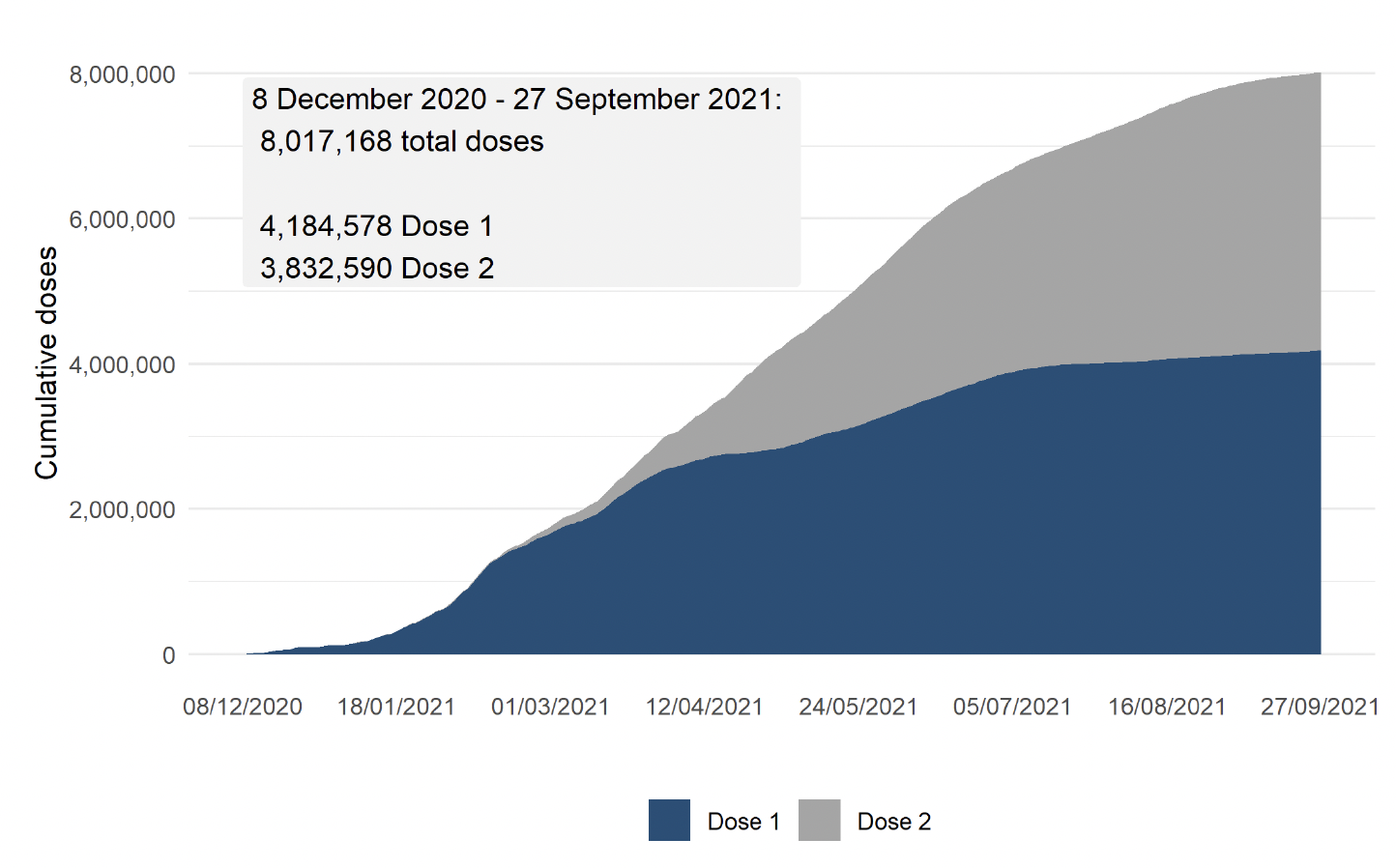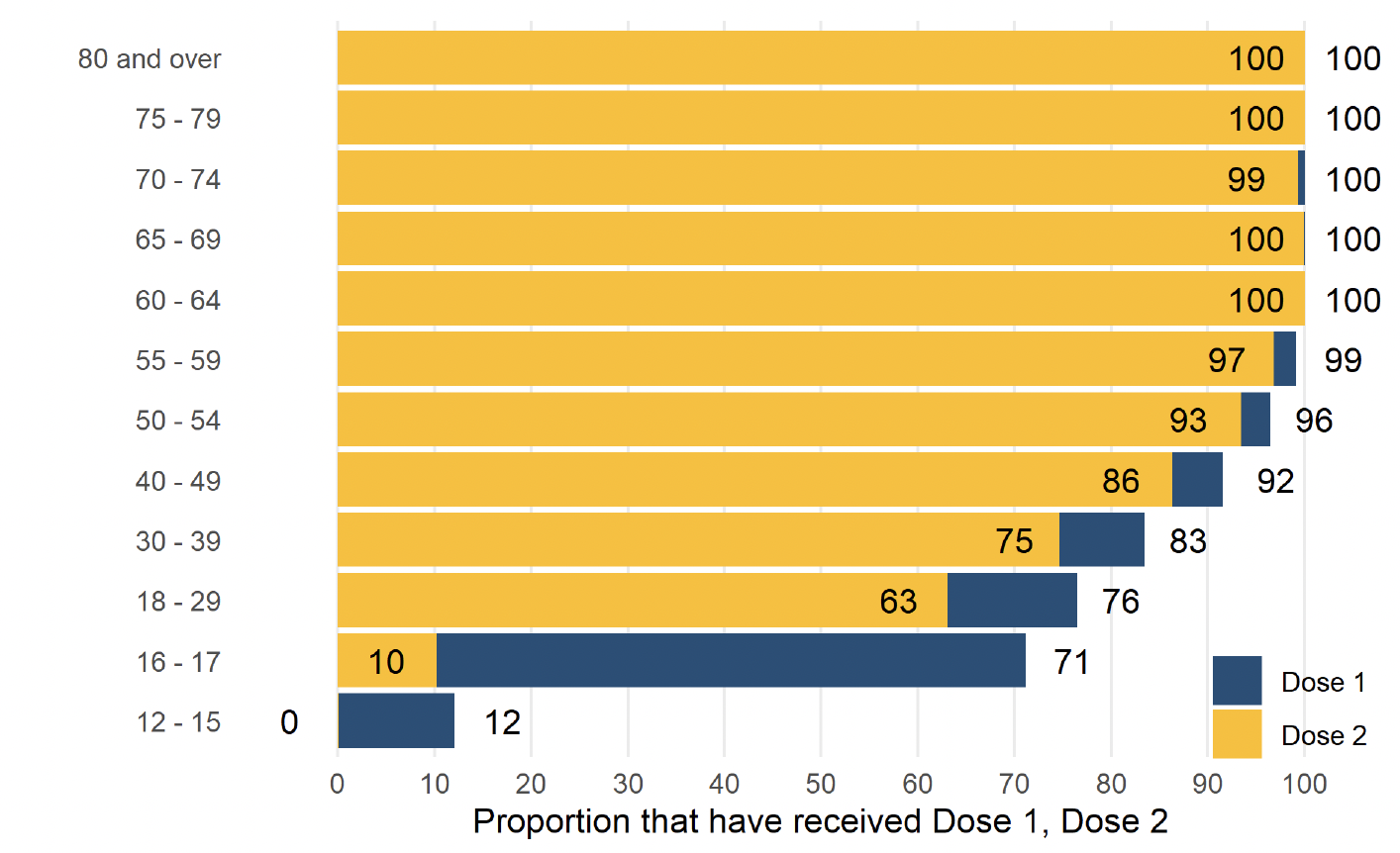Coronavirus (COVID-19): Scotland's autumn/winter vaccination strategy 2021
Strategy outlining our progress on COVID-19 vaccinations and plans for COVID-19 and seasonal influenza (flu) vaccinations in autumn and winter 2021 to 2022 in Scotland.
2. Progress on our COVID-19 Vaccination Programme
How we have prioritised
We set out in our previous COVID-19 Deployment Plans how we would prioritise groups for Phases 1 and 2 of the vaccination programme, informed by JCVI advice. This was particularly relevant as supply initially was limited and therefore it was important that we targeted this to those in the highest clinical need.
On 30 December 2020, the JCVI published advice outlining the initial nine groups for prioritisation as part of Phase 1 of the vaccination programme. This included: those living in residential care homes for older adults; all adults aged 50 years or over; frontline health and social care workers; all those aged 16 to 49 years with underlying health conditions that put them at higher risk of severe COVID-19 (as set out in the Green Book), adult carers; and adult household contacts of immunosuppressed individuals. We followed the JCVI's advice and began vaccinating the groups in the recommended order of priority.
Vaccination prioritisation under Phase 2 continued to be age-based. On 13 April 2021, the JCVI extended their advice to include all those over 18 years. We followed this advice, and continued to vaccinate based on priority groups.
Since the publication of our last Deployment Plan in July, we have continued to expand our vaccination programme, including widening eligibility criteria to include all 12 to 17 year olds. We outline in Section 5 how the JCVI and our Chief Medical Officer's advice have informed our policy on vaccinating 12 to 17 year olds.
Further information on our approach to administering COVID-19 third primary doses and booster doses can be found in sections 5 and 6 respectively.
Progress to date
The COVID-19 vaccination programme has been enormously successful, thanks to the dedication of staff, volunteers and the remarkable response from the public across Scotland coming forward for vaccination. In addition to scheduled appointments and drop-in clinics, other outreach activities have taken place throughout the programme to offer flexibility for people to receive their vaccination.
We have seen high uptake levels across eligible groups with over 8 million vaccine doses administered since the programme began on 8 December 2020. As at 7:30 am on 28 September 2021, there are:
- 4,184,574 people protected through their first dose of the COVID-19 vaccination; 92% of those aged 18 and over and 91% of those aged 16 and over have received their first dose.
- 3,832,498 people provided with further protection by receiving their second dose, of these, 3,821,152 are aged 18 and over which is 86% of all adults.
- 2,831,010 people aged 40 have received their first dose vaccination which equates to 98% of this cohort. 2,750,017 (96%) of this group have now received their second dose vaccination.
As part of our commitment to ensure administration of the programme is fully transparent, we have published daily vaccinations data on figures on the Public Health Scotland (PHS) COVID-19 dashboard. This includes daily vaccination figures by sex, age, location (NHS Health Board and local authority), JCVI priority group and periodically equalities information – uptake by ethnicity and Scottish Index of Multiple Deprivation quintile. This includes both first dose and second dose vaccinations for all those who are eligible for the vaccine.
According to PHS's COVID-19 Statistical Report published on 1 September 2021, the gap in uptake rates between the least and most deprived areas increases from 2.4% in the 75-79 age group, to 10.6% in the 40-49 age group, before it decreases to 7.4% for those aged 30-39 years and to 5.1% for those aged 18-29 year. Uptake for dose 1 in white ethnic groups is high across all age groups, with uptake ranging from 97.6% in the 75-79 age group to 75.2% in those aged 18-29 years, a difference of 22.4%. In contrast, Caribbean or Black ethnic groups have the largest range, with uptake ranging from 93.0% in the over 80s to 53.1% in those aged 18-29 years.
Latest progress by age on first and second doses

* Second doses for 12-15s and 16-17s are only for those with specific health conditions for these groups
Going beyond our original plans
In our March Deployment Plan, we confirmed our planning assumption of 80% vaccination uptake by those in JCVI priority groups 1 to 9. This means we were planning for around 80% of people who were offered vaccination to take up the invitation. Latest progress as at 28 September 2021 shows we have now provided first dose vaccinations far in excess of our original aim of 80% for these priority age groups.
Figure 2 shows as at 28 September 2021 the percentage of people vaccinated by age group, based on the latest available mid-2019 population estimates published by National Records of Scotland. The initial estimate of 80% vaccination take up by those in JCVI priority groups 1 to 9 is shown by a red line.

* Second doses for 12-15s and 16-17s are only for those with specific health conditions for these groups
**Vaccination uptake for groups marked 100% are considered complete based on the estimated eligible population at a set point in time.
Progress for the non-age based JCVI priority groups shows we have provided first dose vaccinations for:
- 98% of current residents of care homes for older adults with 95% having received both doses
- we have vaccinated in excess of the initial target population estimate of staff working in all care homes for both first and second doses.
- 96% of those who were advised to shield, part of the clinically extremely vulnerable group with 94% having received both doses
- 91% of people aged 16-64 with underlying health conditions with 88% having received both doses
- 95.5% of people in specified frontline healthcare roles have received their first dose and 93.1% have had both doses*
- 90.1% of people in specified frontline social care roles have received their first dose and 86.1% have had both doses*
- 64% of people aged 12-15 with underlying conditions
*Specified frontline health care workers and specified frontline social care workers figures provide a more precise measure of vaccine uptake in key frontline roles including registered NHS staff within the job family nursing/midwifery, medical and dental, ambulance services, Allied Health Professions and registered GPs; and registered Scottish Social Services Council staff.
These percentages include all people in the selected age group/JCVI priority group.
There are a number of reasons we have been able to continue to move more quickly through the programme than originally planned. The huge support and responsiveness from the people of Scotland, who have come forward when invited to be vaccinated, has been incredible. We have also continued to see a monumental response from the dedicated staff and volunteers in the NHS and wider partners, including local authorities and the third sector including the Red Cross. This has been an inspiring example of the flexibility and professionalism demonstrated in the excellent working practices by Health Boards and other partners, to respond to this unprecedented health challenge to safeguard lives and public health.
The programme has been delivered with less vaccine wastage than estimated, with a clear focus on protecting as many people as quickly as possible. The pace and effectiveness of the vaccination programme is a tribute to the monumental efforts of every single person involved.
Importantly, Health Boards have ensured their approach is fully inclusive by embedding inclusion throughout the programme to ensure the programme has a wide reach into all communities. This is another important factor in why we have been able to reach more people than we thought possible.
There is a problem
Thanks for your feedback